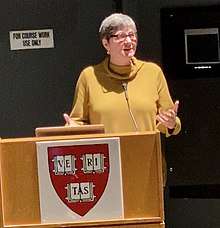Melissa Franklin
Melissa Eve Bronwen Franklin (born September 30, 1956) is an experimental particle physicist and the Mallinckrodt Professor of Physics at Harvard University.[1] In 1992 Professor Franklin became the first woman to receive tenure in the Physics department at Harvard University and she served as Chair of the department from 2010 to 2014. While working at Fermi National Accelerator Laboratory in Chicago, her team found some of the first evidences for the existence of the top quark. In 1993, Franklin was elected a fellow of the American Physical Society. She is currently member of the CDF (Fermilab) and ATLAS (CERN) collaborations.
Melissa Franklin | |
|---|---|
 | |
| Born | September 30, 1956 Edmonton, Alberta, Canada |
| Alma mater | University of Toronto Stanford University |
| Scientific career | |
| Institutions | Fermilab Harvard University |
| Thesis | Selected studies of charmonium decay (1982) |
| Doctoral advisor | Gary Feldman |
| Doctoral students | David Kestenbaum |
Early life and education
Franklin was born in Edmonton, Alberta and grew up first in Vancouver, British Columbia and then Toronto, Ontario, where her family moved in 1962. Her father, Stephen Franklin, was a British-born journalist who worked as drama critic for the Ottawa Journal and later as staff writer and editor for Weekend magazine. Her mother, Elsa, was a television producer as well as Canadian author Pierre Berton's manager and literary agent.[2] Melissa Franklin dropped out of high school to form an alternative school with friends.[3] After attending SEED Alternative School and the Lycee Francais Charles de Gaulle in London, she studied physics at the University of Toronto and graduated in 1977.[3] In the summer of 1977, while Melissa Franklin was a student at CERN, she was part of a legendary bar-room bet with John Ellis which in part led to the naming of Penguin diagrams.[4]
Career
Franklin was a student at CERN in 1978, where she met John Ellis. According to Ellis, he coined the name penguin diagrams following a bet he had made with her in a pub. Franklin earned her physics PhD from Stanford University in 1982 with a thesis titled "Selected studies of charmonium decay" under the supervision of Gary Feldman, working with the school's linear accelerator, SLAC.[5][6] She did postdoctoral work at the University of California at Berkeley in the Lawrence Berkeley Laboratory. In 1988 she became an assistant professor at the University of Illinois, and worked at Fermilab in Chicago. In 1987 she joined Harvard University, later becoming the physics department's first tenured woman professor. For over a decade, Franklin traveled between Boston and Chicago every few weeks, to check on and fix equipment at Fermilab. In 1995, her team proved the existence of the top quark.[7]
At Harvard, Franklin co-directs the Laboratory for Particle Physics and Cosmology (LPPC), alongside Gary Feldman, John Huth, Masahiro Morii and Christopher Stubbs. The LPPC studies topics on the Energy Frontier, the Intensity Frontier and the Cosmic Frontier.[8]
Since the 1990s, Franklin has been a frequent guest on the CBC Radio science program Quirks and Quarks.[9] Franklin has also been a frequent lecturer and "dramatic read[er]" in the annual Ig Noble Prize Ceremonies and other events of the Annals of Improbable Research.[10][11][12]
References
- Archived June 26, 2010, at the Wayback Machine
- Mckillop, Brian (22 June 2011). Pierre Berton: A Biography. McClelland & Stewart. ISBN 9781551996226 – via Google Books.
- Yount, Lisa (1999). A to Z of women in science and math. New York, NY: Facts on File. ISBN 0-8160-3797-3.
- "Melissa Franklin and penguin diagrams". Quantum Diaries Survivor. 2006-02-20. Retrieved 2019-02-20.
- Franklin, Melissa Eve Bronwen (1982). "Selected Studies of Charmonium Decays" (PDF). SLAC. Stanford University. Retrieved 2018-05-21.
- "Biographical Sketch of Melissa Franklin" (PDF). Department of Physics. Harvard University. Retrieved 2018-05-21.
- "Biography: Melissa Franklin". Department of Physics. University of Chicago. Retrieved 2018-05-21.
- "Laboratory for Particle Physics and Cosmology (LPPC)". lppc.physics.harvard.edu. Retrieved 2018-03-02.
- "Harbinger". William Rainey Harper College. – via Internet Archive.
- "Improbable Research: The 24/7 Lectures". Improbable Research. 2017. Retrieved 2019-02-20.
- Abrahams, Marc (2014-09-19). "What happened at the book launch of Too [video]". Improbable Research. Retrieved 2019-02-20.
- "Podcast #8: The scientists who taste-tested tadpoles". Improbable Research. 2015-04-22. Retrieved 2019-02-20.
External links
- Melissa Franklin's Harvard faculty webpage
- Profile on Discovering Women, a PBS series about women scientists.
- Public lecture by Prof. Franklin - includes audio, slides
- Melissa Franklin's profile on INSPIRE-HEP
- "Physics was Paradise" interview with Melissa Franklin